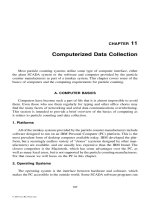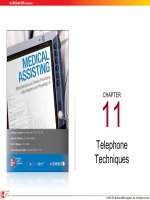Lecture Clinical procedures for medical assisting (4/e): Chapter 11 – Booth, Whicker, Wyman
Bạn đang xem bản rút gọn của tài liệu. Xem và tải ngay bản đầy đủ của tài liệu tại đây (1.47 MB, 45 trang )
CHAPTER
11
Assisting with Cold
and Heat Therapy
and Ambulation
© 2011 The McGraw-Hill Companies, Inc. All rights reserved.
112
Learning Outcomes
11.1 Explain how medical assistants might assist with
some forms of physical therapy.
11.2 Describe ways to test joint mobility, muscle strength,
gait, and posture.
11.3 Discuss the benefits of cold and heat therapies.
11.4 List contraindications to cold and heat therapies.
11.5 Identify various cold and heat therapies.
© 2011 The McGraw-Hill Companies, Inc. All rights reserved.
113
Learning Outcomes (cont.)
11.6 Demonstrate how to perform cold and heat
therapies.
11.7 Describe hydrotherapy methods.
11.8 Identify several methods of exercise therapy.
11.9 Compare different methods of traction.
11.10 Demonstrate how to teach a patient to use a cane, a
walker, crutches, and a wheelchair.
© 2011 The McGraw-Hill Companies, Inc. All rights reserved.
114
Introduction
• Medical assistant
– Common duties
• Apply cold and heat
therapy
• Assist patients with
ambulation
• You may also
– Teach basic
exercises
– Demonstrate how
to use a wheelchair
– Demonstrate the
use of cane,
walker, and
crutches
– Discuss therapies
with the patient
© 2011 The McGraw-Hill Companies, Inc. All rights reserved.
115
General Principles of Physical Therapy
• Physical therapy is a
medical specialty that
treats
– Musculoskeletal
disorders
– Nervous disorders
– Cardiopulmonary
disorders
© 2011 The McGraw-Hill Companies, Inc. All rights reserved.
General Principles of Physical Therapy
116
(cont.)
• Assisting the therapeutic team
– Members
•
•
•
•
Physicians
Nurses
Medical assistants
Other specialists
You must have a
working knowledge of
therapy techniques.
– Coordinate patient
schedule
– Make referrals
– Explain treatment
approach
– Documentation
– Reinforce instructions
– Answer patient
questions
© 2011 The McGraw-Hill Companies, Inc. All rights reserved.
General Principles of Physical Therapy
117
(cont.)
• Specialized
therapies
– Art
– Music
– Dance
– Writing
– Crafts
– Aquatic
– Horticultural
– Equestrian
© 2011 The McGraw-Hill Companies, Inc. All rights reserved.
118
Patient Assessment
• Joint mobility testing
– Range of motion (ROM) – degree to which a joint
is able to move
– Goniometer
– Degree of movement
compared to a standard
measure
• Muscle strength testing
– Determines the amount of force the patient can
exert with a group of muscles
– Compare each side of body
© 2011 The McGraw-Hill Companies, Inc. All rights reserved.
119
Patient Assessment (cont.)
• Gait testing
– The way a person
walks (gait and
swing)
– Includes
•
•
•
•
Length of stride
Balance
Coordination
Direction of
knees and feet
• Posture
– Body position and
alignment
– Checks spinal
curves
– Symmetry of
alignment
• Shoulders
• Knees
• Hips
© 2011 The McGraw-Hill Companies, Inc. All rights reserved.
1110
Apply Your Knowledge
Match description with assessment type:
ANSWER:
___
D How a person walks
A. Joint mobility
A Range of motion
___
B. Muscle strength
C Body position and alignment
___
C. Posture
B Force exerted with a group of muscles D. Gait
___
A Goniometer
___
C Check spinal curves
___
D Length of stride
___
Good Job!
© 2011 The McGraw-Hill Companies, Inc. All rights reserved.
1111
Cryotherapy and Thermotherapy
• Cryotherapy
• Thermotherapy
– Applying cold for
therapeutic
reasons
– Applying heat for
therapeutic
reasons
– Types
– Types
• Wet or dry
• Dry
• Chemical or natural
• Moist
© 2011 The McGraw-Hill Companies, Inc. All rights reserved.
Cryotherapy and Thermotherapy
1112
(cont.)
• Generally promote
healing
• Side effect – damage
to underlying nerves
and tissues
• Monitor patient
closely
• Factors affecting the
use of these
treatments
– Treatment location
– Circulation or
sensation impairment
– Temperature tolerance
– Age
© 2011 The McGraw-Hill Companies, Inc. All rights reserved.
1113
Principles of Cryotherapy
• Constricts blood vessels
• Physiologic responses to cold
– Prevents swelling
– Controls bleeding
– Reduces
inflammation
– Anesthetic effect for
pain
– Reduces pus
formation
– Lowers body
temperature
© 2011 The McGraw-Hill Companies, Inc. All rights reserved.
1114
Administering Cryotherapy
• Dry cold applications
– Ice bags and collars
– Chemical ice packs
• Wet cold applications
– Cold compresses
– Ice massage
© 2011 The McGraw-Hill Companies, Inc. All rights reserved.
1115
Principles of Thermotherapy
• Dilates blood vessels
• Physiologic responses to heat
– Relieves pain and congestion
– Reduces muscle spasms
– Muscle relaxation
– Reduces inflammation
– Reduces swelling
© 2011 The McGraw-Hill Companies, Inc. All rights reserved.
1116
Administering Thermotherapy
• Dry heat therapies
– Chemical hot packs
– Heating pad
– Hot-water bottle
– Heat lamp
– Fluidotherapy
© 2011 The McGraw-Hill Companies, Inc. All rights reserved.
1117
Administering Thermotherapy (cont.)
– Moist heat applications
•
•
•
•
Hot soak
Hot compress
Hot pack
Paraffin bath
– Diathermy – highfrequency wave
achieves deep heat
penetration
• Ultrasound
• Shortwave
• Microwave
© 2011 The McGraw-Hill Companies, Inc. All rights reserved.
1118
Apply Your Knowledge
What is the main difference in the effect of
cryotherapy and thermotherapy that results in the
physiologic response of each?
ANSWER: Cryotherapy causes blood vessels to
constrict, resulting in its physiologic effects, while
thermotherapy causes blood vessels to dilate.
© 2011 The McGraw-Hill Companies, Inc. All rights reserved.
1119
Hydrotherapy
• Use of water to treat physical
problems
• Whirlpools
– Water is agitated by jets of air
under pressure
– Generates hydromassage
• Relaxes muscles
• Increases circulation
– Also used to clean and debride
wounds, ulcers, and burns
© 2011 The McGraw-Hill Companies, Inc. All rights reserved.
1120
Hydrotherapy (cont.)
• Contrast baths
– 2 baths, one hot
and one cold
– Patient moves
quickly from one to
the other
– Purpose
• Induces relaxation
• Improves circulation
• Greater mobility
• Underwater
exercises
– Warm swimming
pool
– Buoyancy takes
pressure off joints
– Purpose
• Promotes relaxation
• Increases
circulation
© 2011 The McGraw-Hill Companies, Inc. All rights reserved.
1121
Apply Your Knowledge
What are the main effects of hydrotherapy?
ANSWER: Hydrotherapy relaxes muscles, increases
circulation, and improves flexibility and mobility.
© 2011 The McGraw-Hill Companies, Inc. All rights reserved.
1122
Exercise Therapy
• Preventive and therapeutic benefits
–
–
–
–
Flexibility
Mobility
Muscle tone
Strength
• Primary treatment for fractures,
arthritis, and some respiratory
diseases
– Minimizes symptoms
– Slows disease progression
© 2011 The McGraw-Hill Companies, Inc. All rights reserved.
1123
Exercise Therapy (cont.)
• Exercise
– Improves muscle tone
and strength
– Maintains ROM
– Improves circulation
– Prevents or corrects
physical deformities
– Relieves stress
– Promotes
neuromuscular
coordination
– Lowers cholesterol
levels
– Aids in resumption of
normal daily activities
© 2011 The McGraw-Hill Companies, Inc. All rights reserved.
1124
Medical Assistant’s Role
• Provide patient
information
– Types of exercise
programs
– Treatment plan
Assist with ROM
exercises
Teach the patient and
family about ROM
exercises.
• Provide support and
encouragement
© 2011 The McGraw-Hill Companies, Inc. All rights reserved.
1125
Types of Exercise
• Choice based on patient’s
physical condition
• Active mobility
– Self-directed exercises
– Increase muscle strength
and function
• Passive mobility
– Therapist or machine
moves the patient’s body
part
– Retain ROM and improve
circulation
• Aided mobility
– Self-directed with
assistance of a device such
as exercise machine
– Retain or improve ROM
© 2011 The McGraw-Hill Companies, Inc. All rights reserved.









